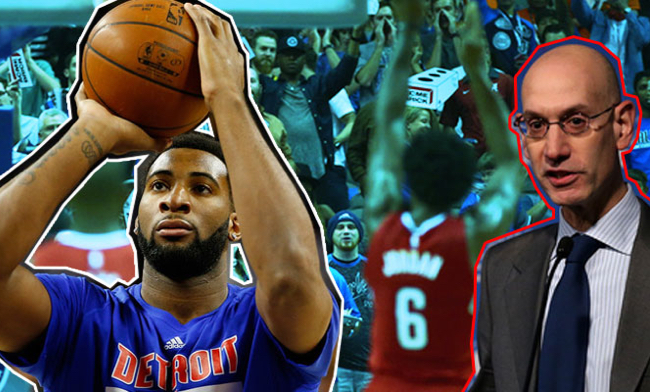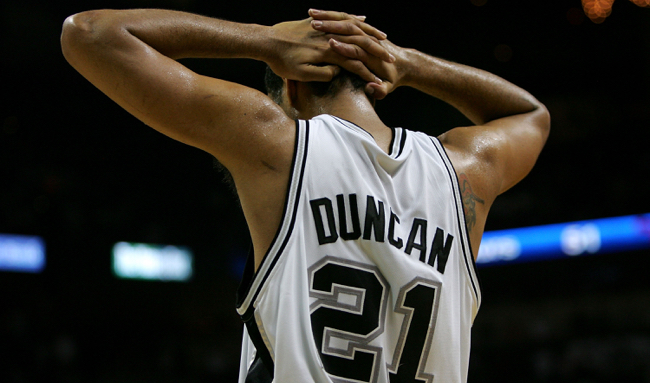
I sorta like watching NBA players shoot free throws — especially in pressure-packed situations. You can see the visible strain of the moment on their face. There’s no face mask, or helmet, or hat with wraparound Ray-Bans obscuring all that emotion. Around this time of year, those tense free throws happen a lot, too. In particular, DeAndre Jordan and Andre Drummond are deeply fascinating to observe from the stripe. You probably know why, too: They’re really bad at free throws.
So bad, in fact, that the Clippers and the Pistons, respectively, score fewer points per possession than the bottom-dwelling Philadelphia 76ers when DJ and DRE are intentionally sent to the stripe. That’s what ESPN shows with this new animated short film about the escalating incidences of Hack-a-Shaq in the contemporary game (forget the fact they have DJ shooting with the wrong hand).
https://i.giphy.com/26AHsuN1qjIliKXmM.gif
https://i.giphy.com/3o6ozF6tH05023e8so.gif
The video also notes that if you add up all the rest of the intentional fouling done this past season, but take out Drummond and Jordan, then teams scored at a higher rate than the league-leading Warriors in those instances where they were intentionally fouled.
https://i.giphy.com/3o6ozB2X7MVmjIXvwY.gif
So, as Kevin Pelton says in the video, that data should take care of all the non-DJ and non-Drummond intentional fouling and we’re left with just those two foul line albatrosses to worry about.
Except, unlike what the conclusion of the video infers, this data actually makes intentional fouling even more impervious from the loud — and growing louder — chorus of fans and analysts who think we should just eliminate intentional fouling altogether.
You know the reasons already. It interrupts the flow of the game, and no one wants to watch players take free throws for three hours, even if they’re going in.
The ESPN video proves this strategy only benefits those teams playing the Pistons or Clippers, though. And because free throws are still a part of the game, opposing coaches will realize this and only intentionally foul Jordan and Drummond. That’s what Pelton says, at least.
So then why was he so adamant we pressure Adam Silver to do away with the rule altogether? We’re changing a rule simply because it reflects poorly on two specific players? That’s a really bad reason to get rid of something. Until DJ and DRE can learn to make their foul shots, that’s a strategy Pistons and Clippers opponents should use. Just because it’s an eyesore to fans doesn’t mean we prohibit it from happening.
Longevity and precedence are never the sole reasons to keep something around, though. Any American with even a cursory understanding of history can appreciate that. So, why – even though it only negatively affects the Pistons and Clippers — keep Hack-a-Shaq on the books? Why let teams slow the game down to a crawl as they make laughable attempts to foul the contemptible culprit who can’t sink shots from the free throw line?
Because it forces people to improve at something. Because it’s actually high drama, sometimes. Because only Andre Drummond and DeAndre Jordan can’t make them at a high enough rate to render an opponent’s hack-a-strategy (hack-a-strat) obsolete. Because, pause, it’s part of the freakin’ game.
I know, I know. You’re already rolling your eyes, and I hate invoking that last bit of rhetoric because it sounds an awful lot like the “white basketball consciousness,” Yago Colas discusses in his brilliant Ball Don’t Lie philosophical treatise about myths, genealogy, and invention in the cultures of basketball. But, there’s something to be said for this seemingly mundane part of the game.
How else are you going to penalize teams for committing fouls? Just award possession? And don’t trot out the argument that Wilt Chamberlain and Bill Russell couldn’t make free throws and both turned out to be all-time greats of the game. Look at how Wilt, Russell and Shaq — the three primary examples for that argument — compare to Drummond and DeAndre Jordan. They aren’t nearly as bad from the stripe as the two contemporary players.
I’m not saying free throws are more exciting than teams going back and forth trying to score more points within an exciting swirl of passing, cutting, defending, blocking and dunking. That’s just basketball, something I’ve loved since uttering my very first word: “ball.” But I also love what free throws can sometimes mean, especially at the end of games and as we get further along in the playoffs. It’s pure drama, within the drama of a basketball game.
In 2005, I was a Tim Duncan hater. Like everyone, I fell in love with the Seven Seconds or Less Suns and couldn’t understand why this walking 12-foot bank shot was terrorizing the whole league. I also had a sneaking suspicion he wasn’t mentally tough enough to hit free throws when it mattered most.
I based that last suspicion on his sporadically subpar free throw percentage and just how uncomfortable he looked at the stripe. In 2001, he connected on fewer than 65 percent of his attempts from the line and he dipped all the way below 60 percent in the 2004 season. All told, there are four seasons in Tim Duncan’s career where he shot worse than 65 percent from the free throw line. In the playoffs, sometimes it was worse. In 2010, he shot worse than 50 percent from the stripe over 10 games.

But in the early spring of 2005, no one was really talking about Duncan at the free throw line, nor should they. Duncan had just finished perhaps the four best seasons of his career, winning back-to-back MVP awards, a second title and All-NBA First Team status for the foreseeable future. He seemed destined to go down as the greatest power forward in the history of the game.
And he was the best player in the game at the time, but he shot just 9-for-21 from the stripe in Games 5 and 6 of the Finals against Detroit that June. Not only that, but in Game 5, his six free throw line misses in the fourth quarter nearly cost the Spurs the win. If Robert Horry hadn’t added to his legend in the fourth quarter and overtime, Duncan would be a different kind of goat. He admitted as much after the game, too.
That’s some high drama right there.
Duncan ended up hitting his free throws in Game 7 (5-of-6), a Spurs win, and I remember thinking he had mentally turned a corner. Duncan wasn’t ever gonna let a big moment at the free throw line get the best of him, despite a stroke from the stripe that wasn’t as accurate as he might’ve liked.
Tim Duncan proving to me he could hit big-time free throws under the glare of the Finals spotlight against the Pistons in 2005 is a rather obscure and subjective reason for keeping the hack-a-strategy in place. And I’m probably one of about five people who even watched that Finals series. But when teams realize intentionally fouling only works against DeAndre Jordan and Andre Drummond, the number of incidences will drop — or those teams’ decision-makers will be replaced.
And Doc Rivers and Stan Van Gundy will either have to use thinking so far out of the box we doubt it’ll ever happen, or sub their rim-protecting, rebounding centers out of the game.
Not to belabor the point further, but that’s just part of basketball, and we sorta love it.
(ESPN)






